Janapada Sampada
Introduction – Bamboo And Cane Culture Of Arunachal Pradesh

Bamboo Bottle
Arunachal Pradesh has a vibrant craft tradition and every tribe excels in craftsmanship. Cane and bamboo is an important craft of this area, and the workmanship is of a very high order. Many tribesmen make their own hats, which are often extremely decorative, adorned with the beaks and feathers of birds or with tufts of hair dyed red. They also make varieties of baskets, bags and other containers. There is a wide range of cane belts, woven and plain, and in northern Subansiri, tribals have even elaborately woven brassieres of cane and fibre.
Cane and bamboo is strictly men’s craft and the most commonly made objects are baskets for storing ad carrying paddy, fuel and water, vessels for preparing local liquor, rice plates, bows and arrows, headgear, mats, shoulder bags, etc. ornaments and necklaces made of fine strips of bamboo and grass are also popular. Burnt pokerwork too is executed on bamboo articles.
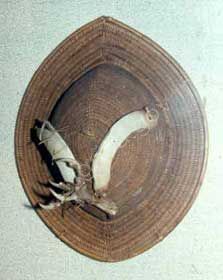
Hat, Adi Tribe
The Bangnis, Apatanis, Hill Miris and Adis are expert workers in cane and bamboo. They make beautiful baskets, bags, hats and even jewellery that speak eloquently of their skill. The Monpas and Sherdukpens do make the use of bamboo but not to the extent as in other cultural areas. Bamboo is used for basketry. Basket making is a major craft in these areas. They produce baskets, grain holders, rice beer containers, haversacks, food plates, etc. from bamboo. From cane, they produce headgears, cane belts, anklets, chairs, tables, wardrobes, toys, etc. Their domestically produced articles from bamboo and cane meet all their requirements in basketry. Now of course several centres have been established by the government to manufacture basketry on a commercial basis. Throughout, the twill and hexagonal, both open and closed techniques of basketry are followed.
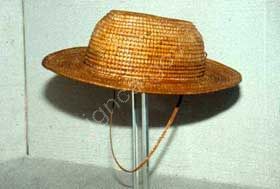
Hat, Mishmi Tribe
Dyed cane or bamboo strips are generally used for various items of dress instead woven into a basket. Among the Apatanis, dyed cane strips are used for making a kind of waistband locally known as awoo. The Nishis dye bamboo strips in black and are specially used for making hand fans. The Noctes and the Wanchos mostly use dyed cane strips for their headgear, waistband, headband, armlet, etc. Sometimes dancers’ baskets used in dancing are also decorated with a limited number of dyed strips. Colours used in dyeing are limited. The most common shades are red, black and yellow. The Apatani waistband is dyed red. The Wancho and the Nocte headgears are invariably woven of red cane strips. Yellow and black colour occasionally noticed.
The Monpas however paint their strips in a variety of colours of which red, pink, brown, yellow, green and blue are common. Besides, varieties of blended colours are also noticed. The Nishis and the Bangnis dye bamboo strips black for their hand fans. In Arunachal Pradesh, the dyeing material is vegetal substance.

Cane Hat, Idu Mishmi Tribe
The preference for a particular colour seems to depend upon the natural resources. The black and the red are the only colours, which could be produced out of known vegetables dyes grown wild in this region and hence their preference for these two colours. The Monpas however use modern paints and therefore varieties of blended colours are found.
To the Apatanis dyeing not only enhances the beauty of the specimen but also it is considered as good preservative. Thus, it is noticed that the Apatani cane waist-band or awoo, in spite of its constant use remains as it is without much wear and tear. The dyes have protective property as it keeps away insects and fungus from damaging it.
The bamboo and craft of Arunachal Pradesh is very promising. It needs an appropriate direction so that people may follow this craft, develop the capacity to produce more and more of it by the utilization of their own imagination and traditions. The future is bright with lot of hope and scope for extending this tribal craft to reach its zenith.
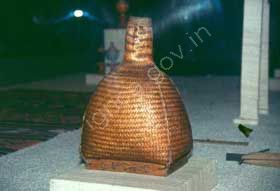
Bottle, Monpa Tribe
Cane and bamboo form the raw material which meet the requirements of everyday life-from house building to making baskets, fishing traps, items of dress, construction of suspension bridges, religious paraphernalia, etc. in fact there is nothing in a tribal huts which is made without using indigenous plants. People of Arunachal Pradesh have fully utilized the raw material offered buy the ecology of the region.
It has been noticed that the Poaceae and Arecaceae are the two main plant families, which have shaped the material culture of the people of Arunachal. Various species of bamboo belong to the family of Poaceae. Given below is a list of species according to botanical convention. (i) Dendrocalamus Hamiltonii. (ii) Dendrocalamus Hookerii. (iii) Dendrocalamus Giganteus. (iv) Pseudostachyum Polymorphum. (v) Cephalostachyum Fuchsianum. (vi) Bambusa Pallida.

Cane Hat, Mishmi Tribe
Next to the family of Poeceae, the most important plant that plays a great role in shaping the material culture of Arunachal belongs to Calamus group of the Arecaceae family. There are various species of canes, which are constantly used for making basket containers, items of dress, lining of various objects and construction of suspension bridges.
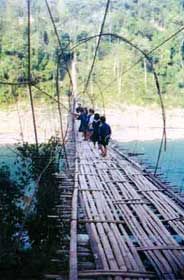
Adi Cane Bridge
A few species is identified below:
(i) Calamus Tenuius.
(ii) Calamus Guruba.
(iii) Calamus Extensus.
(iv) Calamus Erectus.
(v) Calamus Leptospadix.
(vi) Calamus Floribundus.
(vii) Calamus Flagellum.
(viii) Livistona Jenkinsiana.
(ix) Pinanga Gracilis.
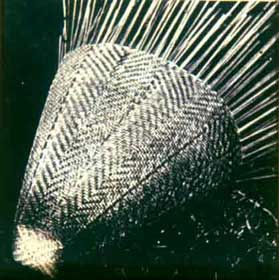
Gallong Bamboo Basket
Considering function, i.e. the utility as the basis, the whole range of basketry taken into consideration, cam be conveniently classified into the following broad divisions:
1. Carrying basket
2. Storage basket
3. Receptacle
4. Straining basket
5. Decorative basket
6. Fishing basket
7. Mat
8. Miscellaneous objects
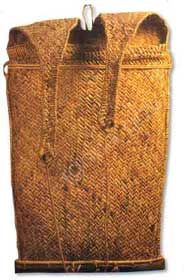
Haversack Baskets (Using fine bamboo strips), Tagin Tribe
Besides these, there are a large number of objects produced through basketry technique. They are used for miscellaneous purposes such as objects of personal adornment, dress, defense, etc. This group of objects may be classed as basketry objects of miscellaneous utility.
Classification of Baskets in respect to their shapes
Conical Basket
Baskets of conical shapes are invariably used for carrying purposes. They are commonly found among the Daflas, Hill-Miris, Tagins, Gallongs, Noctes and Wanchos. There are sufficient reasons to show that here is definite relationship between the topography and the conical shape of these baskets. The Dafla carrying basket, which is locally known as ege, may be regarded as one of the perfectly suited basket from technical point of view, as far as adaptation to the topography is concerned. Dafla villages are situated in the high spurs of mountain ranges. Their jhum fields, water sources and game reserves are located far away beyond the village limits. As a result, they have to carry their loads such as paddy, firewood, water tubes, etc., on their backs and climb high up the mountain. In this process with the basket on the back while climbing up, the carrier naturally has to bend in such a way as to form a 120-degree angle from the horizontal. Another feature of this Dafla basket is that it is more advantageous for carrying things.
The portion of the wall of the basket that rests upon the back of the carrier is almost flat and straight and the portion just opposite to it bulges outward. The flat portion is slightly flexible to rest comfortably on the back.
Semi- conical Carrying Basket
The carrying baskets of Padam, Miniyong, Pasi, Digaru, Mishmi, Sherdukpen, etc., who inhabit the foothills and flat valleys, reveal a uniformity in shape; they are nit perfectly conical. Though these baskets have tapering outlines, yet they invariably have flat bases.
Some of the baskets such as bye of the Padams and Egin of the Miniyong are provided with four short legs at the base. On the other hand, Digaru Mishmi carrying basket such as thee has a short flat bamboo stand secured around the base by means of cane strips.
Cylindrical Basket
These baskets are of straight outline and have perfectly flat bottom. They are used for storing as well as for carrying articles. The baskets used for storing grain in the granary have uniformity in shape all over in this region. They have a flat base, round and straight outline. Normally these baskets are 3 to 4 feet in height and about 4 feet in diameter. Since the utility is restricted to the houses, this type of basket with a flat base and straight outline has its own advantage. Apatani carrying baskets are cylindrical in shape with flat bottoms. Womenfolk for carrying light loads such as vegetables, seeds, etc., normally use them.
Flat Basket
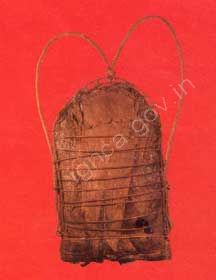
Haversack Basket
Distribution of this type of carrying basket seems to be indicative of the influence of the climatic factor, as far as the state of Arunachal Pradesh is concerned. The best examples to illustrate this point is the indigenous haversacks or flat wallets like baskets commonly found among the Tagins, Daflas, Hill Miris and Adis.
This basket is flat and carried by means of two shoulder straps. The outer surface of some of the Adi haversacks, such as the nara are slightly concave. This makes the baskets little more spacious. The very shape of this basket renders a natural protection against the rain. It prevents water from accumulation on the surface of the basket and helps the water to trickle down slowly and gradually. They are sometimes lined with a kind of bark to make it doubly sure that the water is not absorbed inside.
The Dafla ‘tali’ is a perfect flat haversack. To make it rainproof, tama fibres are fitted on to the outer surface. Because of the flat nature of the basket, the tama fibres are more effectively used to render the basket complete waterproof.
Basket with constricted mouth
Most of the smaller baskets found among the Daflas, Hill Miris, Adis, Mishmis and Tangsas have usually constricted mouth in relation to the size of the body. They are almost round in shape. A good example of such a basket is the husak, of the Gallongs. The height of the basket is about 10 cm and maximum girth is about 20 cm. The diameter of the mouth is 5 cm.
Basketry Objects of Miscellaneous Utility

Front view of Haversack Basket
This group of objects can be divided into: –
- Defensive weapons: rain shield, helmets, headgear and shields
- Items of dress: wristband, calflet, armlet, anklet, breast bands, etc.
- Household articles: winnowing fan, hand fan, drying tray, etc.
Tools and Implements used in Basket Making
The only tool, which is commonly used for the manufacture of baskets and various other objects manufactured, is a sort of long knife, popularly known as dao. Besides the dao and knife, iron and bone needles are required in coil basketry. The needles are thin, round with tapering ends. Among some tribes, two different types of needles are found. One of them is used for finer work and the other for rough work. Bone needles are extremely rare. The socio-religious significance of dao is as important as its utilitarian value. The importance of dao in the socio-economic life of the people of Arunachal Pradesh can be gauged only when the peculiar topographical and socio-politico conditions are taken into account.
Basketry Technique/ Basketry Patterns
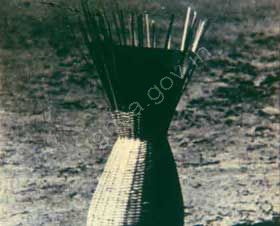
An Indigenous Mould
Three main varieties-checker works, twilled and hexagonal of woven basketry are seen throughout Arunachal Pradesh. Plaiting and twining techniques on the other hand are sparse, and are generally used for making various basket appendages instead of the proper basket.
It is seen that the angular and cross patterns are frequent among the Adi baskets, while diamond is the usual motif among the Apatanis and Mishmis. Basketry patterns are extremely limited in Arunachal and the patterns are invariably geometric especially frequent among the baskets of the Adis, Apatanis, Daflas, Mishmis and the Monpas. Each geometrical pattern and the meaning attached to it is the ultimate result of realistic thought.
Socio-Religious Significance
Cane and bamboo figures extensively in the complete material culture of Arunachal Pradesh. With the use of cane and bamboo as raw materials, the basketry technique naturally occupies a very important place in the technological development. It has already been stated that the use of basketry technique is not confined to the manufacture of baskets only. It is employed for all purposes from building of cane suspension bridge to religious paraphernalia. Even the small articles of personal adornment such as calflets, leglets, necklaces, etc., are also made of basketry-work. The plaiting of dao handles and making dao sheath are noteworthy examples of varied use of basketry technique.
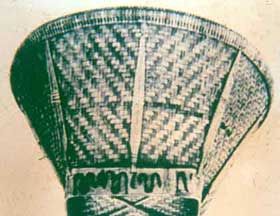
4cm wide strip of bamboo is heated and bent to form a square “false base” of the basket.
Probably the most significant occupational aspect of basketry, in Arunachal Pradesh lies in the fact that it is exclusively reserved for the men folk. The womenfolk on the other hand have exclusive control over textile weaving. There is some explanation to show as to why men monopolize this particular craft. The people of Arunachal Pradesh are mostly food producers. Unlike the people of the Brahmaputra valley, here we encounter a peculiar situation about the division of labour. The womenfolk are actual producers. In agricultural operation the work of the men folk is restricted to felling trees and clearing jungles. Under such circumstances, women folk are mostly found busy either in the Jhum field or in gathering food round the year. The men folk enjoy considerable leisure throughout the year. These leisure hours are spent in manufacturing the household articles, of which basketry forms a major item.
Hence cane and bamboo work constitute the major cottage industry in Arunachal Pradesh. In Arunachal, there is no economic surplus but because of careful division of labour, there is immense leisure enjoyed for menfolk, which is utilized in productive work. Therefore, the national life is extremely productive and artistically well developed.
The social significance of the objects of basketry-technique depends mainly on the symbolic value. The symbolic value is focused through: (i) basketry as item of dress and (ii) basketry as an object of political tribute.
All the religious structures such as altars, effigies, etc are constructed for performance of religious ceremonies and rituals are made of and decorated with objects of basketry technique. Effigies representing deities and spirits found among the Apatanis, Nishis, Adis are made of split bamboo in basketwork.

Basket fairly large square base & wide circular mouth. Basket is woven in a twill weave.
The technique and habitat are directly interlinked. Therefore, the techno-typological study of basketry becomes meaningless if the nature of the topography, the climate and the ecology is not taken into account. Therefore, there exists a technological balance in between the mountain topography, the shifting and terrace cultivation and a bamboo and cane based material culture. Basketry, as an aspect of traditional industry has definite bearing on the economy. Further, the socio-political condition of a particular group of people is also reflected on the economic life. Hence, the functional study of basketry is bound to reflect the social, political and economic life of the group. Many social phenomena such as division of labour on craft basis, ceremonial weaving of matting as the basis of tribal solidarity, material object like basket as the form of tribute and political authority are dynamically interrelated with the functional aspect of basketry of Arunachal Pradesh. Besides the symbolic value attached to certain baskets, (such as the basket used in Mopin festival of the Adis and ‘Ozealle’dances of the Wanchos) and other cognate objects have a definite functional orientation.
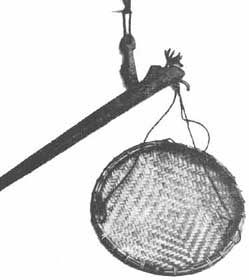
Balance weigh pan (made of plaited bamboo)
Vankhaong
The Vankhaong is a winnowing fan made by the Nocte tribe.
Apatani Bamboo Ladle
The Apatanis use an interesting ladle to lift water stored in their bamboo water tubes. It is made in two parts, the container and the handle.
Apatani Bamboo Comb
The Apatanis and Nishis of Arunachal use combs carved out of single piece of bamboo. A wide chip of a fairly thin walled bamboo is used. The combs have coarse widely spaced teeth on one side and thinner closely spaced teeth on the other. A part of the nodal ring separates the two sets of teeth. The internal nodal ring is cut flat on the inside of the comb, and the outside ridge is retained as a decorative element. These combs are functional as well as decorative.
Sudhum
The Apatani smoking pipe is called sudhum. The bowl is made from a cane called tarre while the stem is made from the reed bamboo called pepu. The hollow of the bowl is created by burning, to remove the soft pulpy centre of the cane. A similar pipe is made by the Apatanis where the bowl is made from bamboo.
The Nishi tribe of Subansiri District in Arunachal makes a pipe similar to the Apatani one, and is called hutusilli.
Yatee

Cap, Apatani Tribe
The Yatee, the Apatani rain shield from Arunachal, is made in two parts, held together by long loops of twisted bamboo rope. The top part is rectangular. The second part is a flat rectangular piece that shields the back. Both parts have braided bamboo straps that rest on the forehead. When the top part is not required, it is pushed back to hang suspended from the back shield by two long loops of twisted bamboo rope.
Both parts are made with two layers of an open-hexagonal weave, sandwiching a layer of leaves between them. All the edges are held between two half splits of cane tightly bound together.
Monpa Hat
The Monpa tribe of Arunachal Pradesh uses a shallow conical hat to protect them from the sun and rain. The hat is made in two layers. The outer layer is woven in close diagonal twill, while the inner layer is made in an open-hexagonal weave. To make the hat waterproof, a layer from the stem of a banana tree is dried and sandwiched between the layers. The layers are held together around the edge which is sandwiched between two strips of cane, tightly bound together. A braided bamboo headband is fitted inside the hat, which is held on to the head by a strap looped below the chin.
Bopa

Hat (Hornbill, Hair & Cane), Adi Tribe
The Apatani and Nishi tribes of Arunachal use coiled hats that fit close on to the head like a skull cap. The bopa is slightly conical in shape. These hats are decorated with twisted cane ropes, and a hornbill beak that is dyed red.
Bolup
The bolup is a hat used by the Adi Gallong tribe of Arunachal. It is made by coiling lengths of cane to obtain a semi-elliptical bowl with a horizontal boat-shaped rim. The hat is extremely sturdy. A similar construction is used in hats made by other tribes of Arunachal. The form and decorative elements vary, but the basic structure is similar. In some cases, there are thick strips of cane that are tied onto the head as extra protection. In other hats, dyed wool or feathers are used as decorative elements.
Apatani; Adi; Bangni; Dafla; Digaru; Gallong; Hill Miri; Monpa; Mishmi; Mininyong; Nishi; Nocte; Pasi; Padam; Sherdukpen; Tagin; Tangsa; Wancho: Tribes of Arunachal Pradesh.
Tama: The tama fibres are obtained from a species of sago palm locally known as tache.




